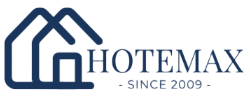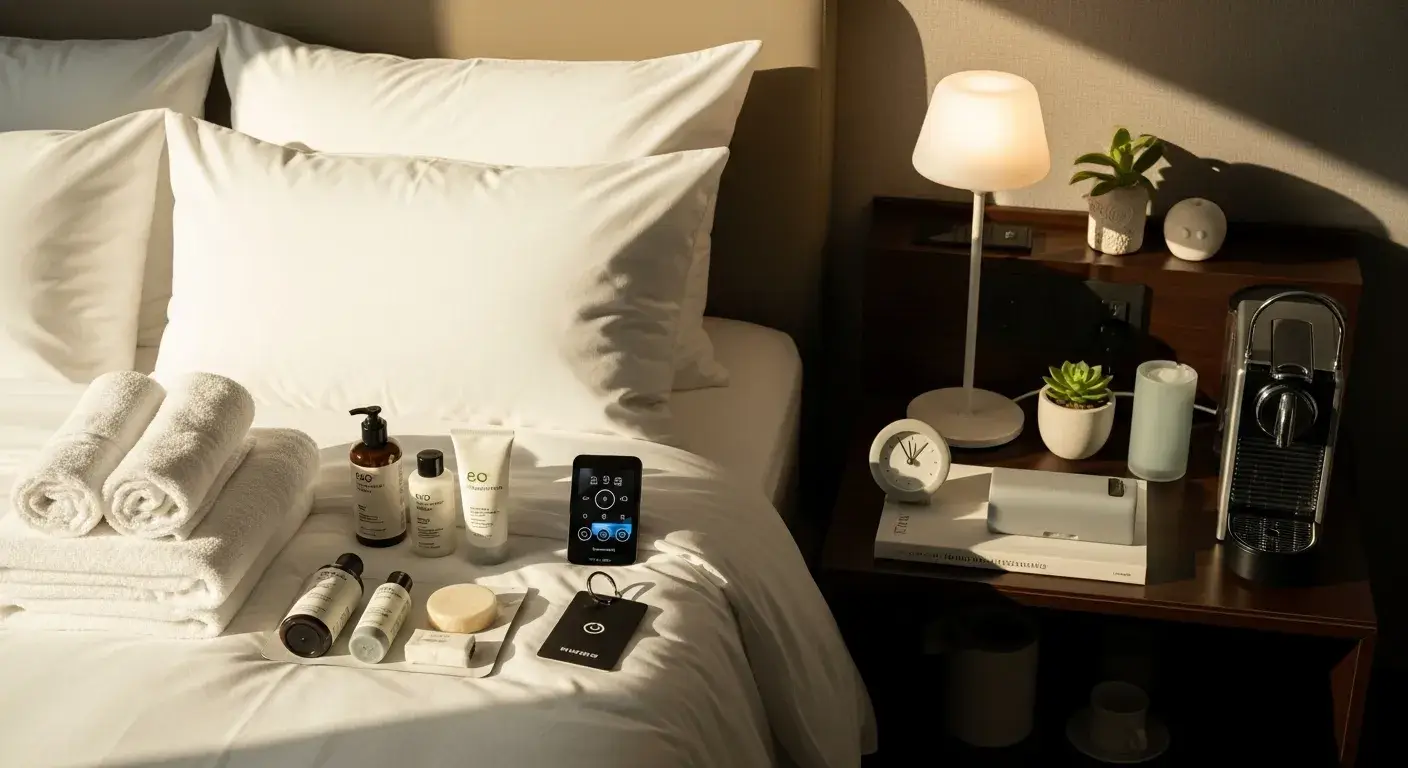
Hotel supply costs are rising, but guest expectations keep climbing. You need the right items without overspending on unnecessary luxuries.
Essential hotel supplies fall into six core categories: guest room bedding and bathroom items, housekeeping supplies, safety equipment, technology amenities, sustainable products, and operational tools. Properties typically need 40-60 different items, with bedding and bathroom supplies accounting for 60% of guest satisfaction scores.
I’ve analyzed current market trends, guest feedback data, and procurement best practices to create this definitive guide. You’ll discover which items truly matter for guest satisfaction and operational efficiency.
What Defines Essential vs. Nice-to-Have Hotel Supplies?
Rising operational costs force you to distinguish between must-have items and optional luxuries. Smart procurement starts with understanding this difference.
Essential hotel supplies directly impact guest comfort, safety, or legal compliance. Nice-to-have items enhance experience but aren’t required for basic operations. The distinction varies by property type and target market segment.
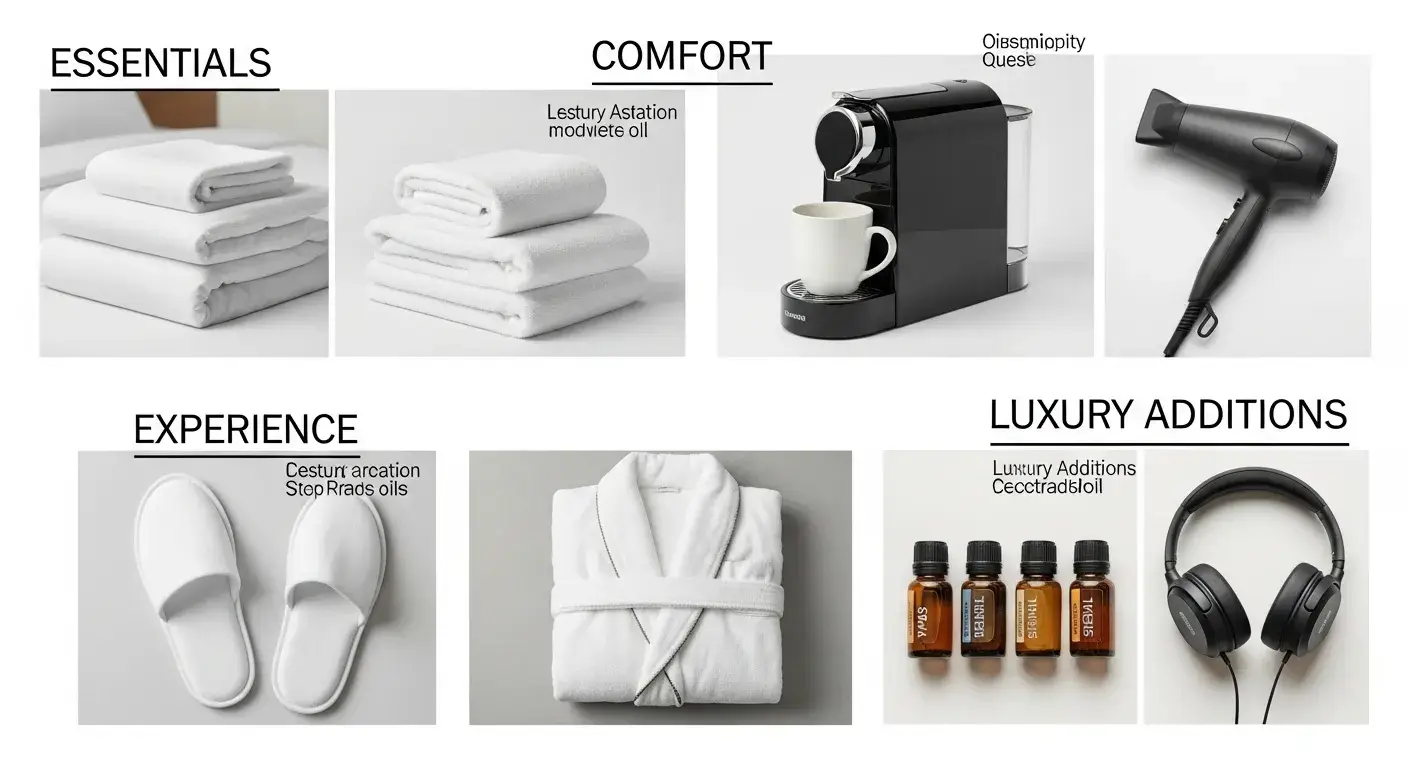
The Four-Tier Classification System
I use a four-tier system to categorize hotel supplies based on guest impact and operational necessity:
Tier 1: Critical Essentials (Non-negotiable)
- Guest room bedding (sheets, pillows, blankets)
- Bathroom basics (towels, toilet paper, soap)
- Safety equipment (smoke detectors, fire extinguishers)
- Housekeeping supplies (cleaning products, trash bags)
Tier 2: Comfort Essentials (High Guest Impact)
- Hair dryers and mirrors
- Coffee makers and supplies
- Wi-Fi equipment and charging stations
- Quality lighting fixtures
Tier 3: Experience Enhancers (Moderate Impact)
- Bathrobes and slippers
- Mini-fridges and microwaves
- Premium toiletries and amenities
- Decorative items and artwork
Tier 4: Luxury Additions (Low Priority)
- Spa-quality products
- High-end electronics
- Specialty furniture pieces
- Premium branded items
| Supply Category | Guest Priority Score | Operational Impact | Budget Allocation |
|---|---|---|---|
| Bedding & Linens | 95% | High | 25-30% |
| Bathroom Supplies | 90% | High | 20-25% |
| Cleaning Products | 85% | Critical | 15-20% |
| Technology Items | 88% | Medium | 10-15% |
| Safety Equipment | 100% | Critical | 8-12% |
| Amenities | 70% | Low | 5-10% |
Regional and Property Type Variations
Different hotel segments require different supply priorities. Budget hotels focus on Tier 1 and 2 items, while luxury properties include Tier 3 and 4 supplies.
Boutique hotels in urban areas prioritize tech amenities like USB charging ports and high-speed Wi-Fi. Resort properties need pool supplies, outdoor furniture, and recreational equipment. Business hotels emphasize work-friendly items like desk lamps and iron/ironing boards.
Climate also affects essential supply lists. Properties in humid climates need dehumidifiers and mold-resistant materials. Cold-weather locations require extra blankets and heating equipment.
Which Bedding and Bathroom Items Drive Guest Satisfaction?
Guest room comfort directly correlates with review scores and repeat bookings. J.D. Power research1 shows 78% of guests prioritize sleep quality above other amenities.
High-quality bedding increases guest satisfaction scores by 23% and generates 15% more positive reviews. Essential items include 200+ thread count sheets, hypoallergenic pillows, and durable blankets that maintain comfort after 100+ washes.
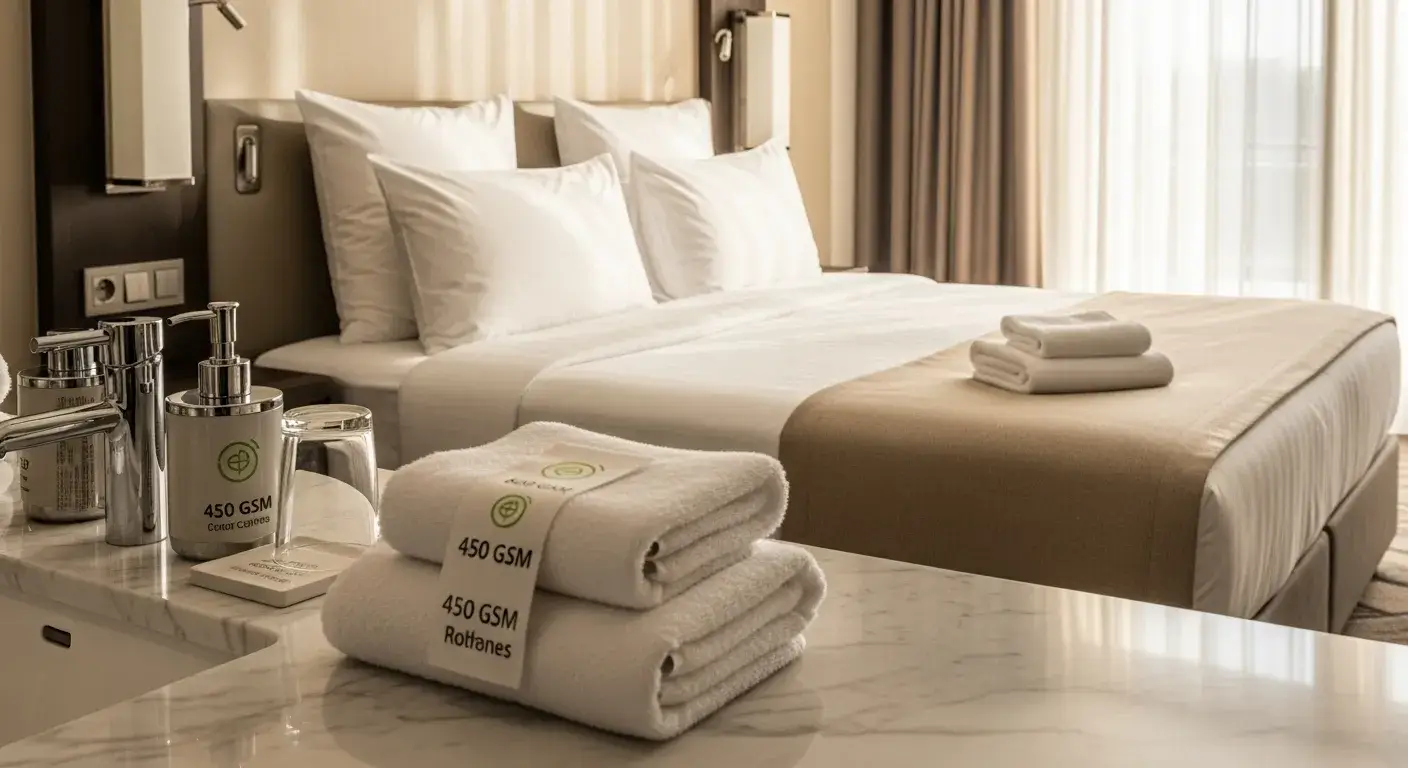
Bedding Specifications That Matter
Thread count isn’t everything, but it’s a reliable quality indicator. I recommend these minimum standards:
Sheet Requirements:
- 200+ thread count2 cotton or cotton blend
- Percale or sateen weave for durability
- Deep pockets (15+ inches) for modern mattresses
- Fade-resistant colors (white, ivory, light gray)
Pillow Standards:
- Hypoallergenic synthetic fill or down alternative
- Medium firmness to accommodate most sleep preferences
- Machine washable and quick-drying
- Standard size (20" x 26") for versatility
Blanket and Comforter Specs:
- All-season weight (6-8 lbs for queen size)
- Microfiber or cotton shell with synthetic fill
- Easy-care instructions for housekeeping efficiency
- White or neutral colors to hide minor stains
Bathroom Supply Priorities
Bathroom cleanliness ranks second only to bedding in guest satisfaction surveys. Focus on these essential items:
| Item Category | Essential Products | Quality Standards |
|---|---|---|
| Towels | Bath, hand, washcloth | 400+ GSM, 100% cotton |
| Toiletries | Shampoo, conditioner, soap | Pump dispensers, eco-friendly |
| Fixtures | Hair dryer, mirror | Wall-mounted, 1800+ watts |
| Accessories | Tissue box, waste bin | Refillable, easy-clean materials |
Cost vs. Quality Balance
Premium bedding costs 40-60% more than basic options but lasts twice as long. I calculated the true cost per use:
- Basic sheets ($15/set): Replace every 6 months = $30/year
- Premium sheets ($35/set): Replace every 18 months = $23/year
The premium option saves money while improving guest experience. Similar math applies to towels, pillows, and other bedding items.
Bulk purchasing reduces costs by 20-35%. Properties with 50+ rooms should negotiate directly with manufacturers for custom specifications and better pricing.
How Do Housekeeping and Safety Items Impact Hotel Efficiency?
Operational efficiency depends on having the right cleaning supplies and safety equipment. Poor choices here increase labor costs and create compliance risks.
Efficient housekeeping supplies reduce room cleaning time by 15-20 minutes per room. Safety equipment prevents costly violations and protects guest welfare. Together, these items represent 25-30% of total supply budgets but drive 60% of operational efficiency.
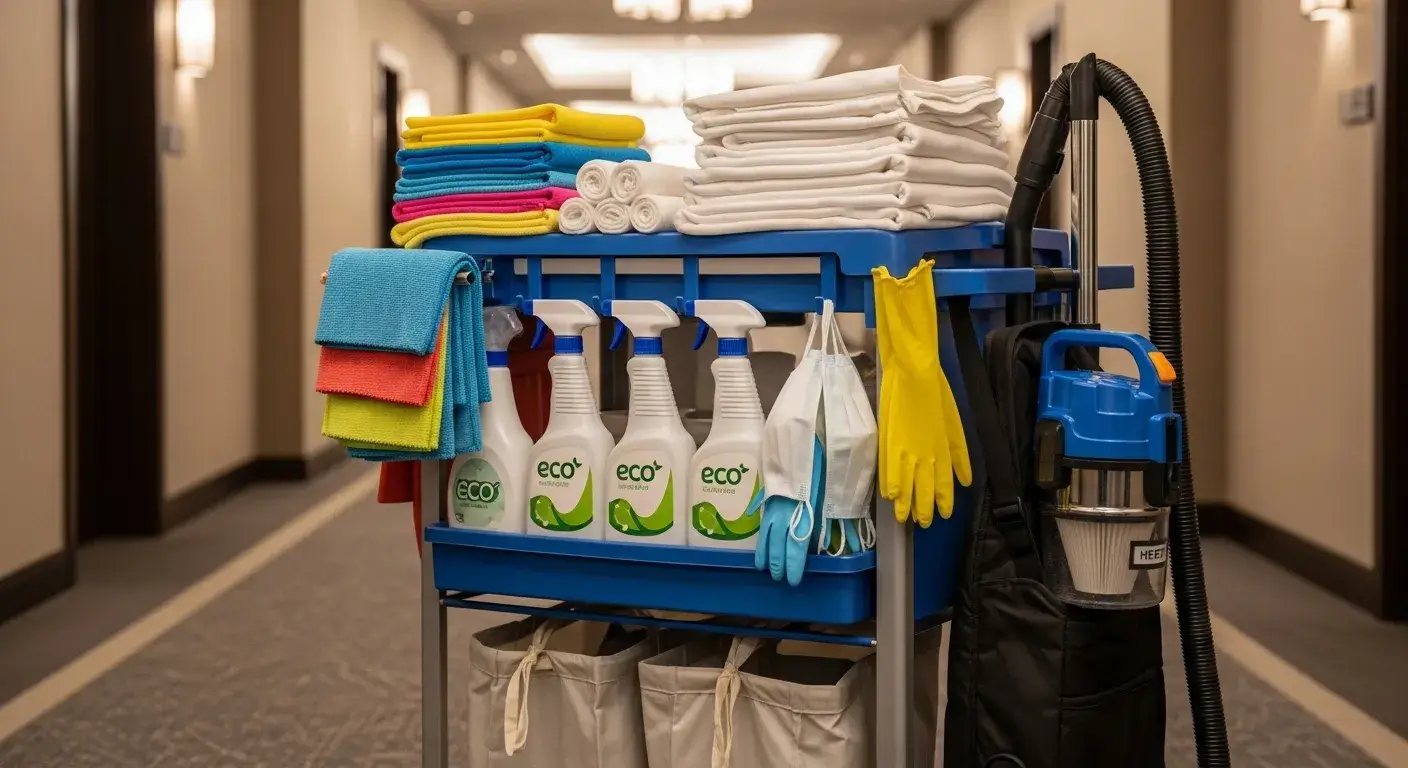
Housekeeping Supply Essentials
Modern housekeeping requires specialized products for different surfaces and cleaning tasks. Generic cleaners don’t work effectively and waste staff time.
Cleaning Product Categories:
- All-purpose cleaners for general surfaces
- Bathroom cleaners with disinfectant properties
- Glass cleaners for mirrors and windows
- Carpet spot removers for quick stain treatment
- Floor cleaners appropriate for your flooring type
Equipment Requirements:
- Commercial vacuum cleaners with HEPA filtration
- Microfiber cleaning cloths (replace paper towels)
- Housekeeping carts with organized compartments
- Laundry bags and sorting systems
- Protective equipment (gloves, masks)
Safety and Security Items
Legal compliance requires specific safety equipment in all hotel rooms. Missing items result in fines, closure orders, and liability issues.
Mandatory Safety Equipment:
- Smoke detectors with fresh batteries
- Carbon monoxide detectors (where required)
- Fire extinguishers on each floor
- Emergency flashlights in rooms
- First aid supplies at front desk
Security Considerations:
- In-room safes (recommended for 3+ star properties)
- Door locks with backup key systems
- Peepholes or security cameras in hallways
- Emergency contact information displays
Efficiency Metrics and ROI
I track these key performance indicators to measure supply effectiveness:
| Metric | Target Range | Impact on Operations |
|---|---|---|
| Room Cleaning Time | 20-30 minutes | Labor cost optimization |
| Supply Cost per Room | $15-25/month | Budget control |
| Guest Complaint Rate | <2% | Satisfaction maintenance |
| Safety Violations | Zero | Compliance assurance |
Properties using optimized supply lists reduce housekeeping overtime by 25% and improve room turnover speed by 18 minutes per room.
Investing in quality supplies pays dividends through reduced replacement costs, improved efficiency, and better guest reviews.
What Tech-Based Supplies Are Now Non-Negotiable?
Technology integration transformed from luxury amenity to basic expectation. Post-pandemic guests demand contactless options and reliable connectivity throughout their stay.
Wi-Fi infrastructure, charging stations, and smart room controls are essential technology supplies in 2025. Properties without reliable internet access receive 40% more negative reviews, while USB charging ports increase guest satisfaction by 12%.
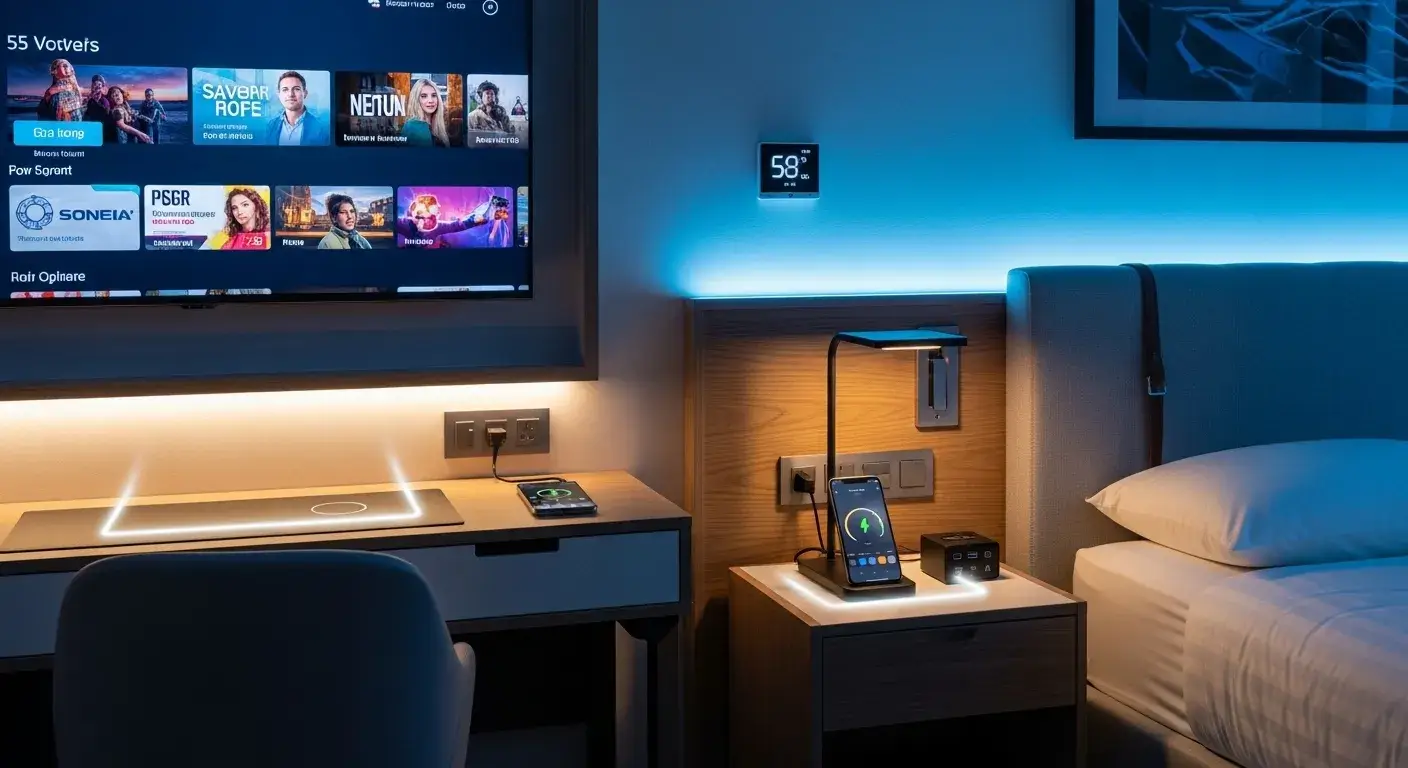
Essential Technology Infrastructure
Modern guests travel with multiple devices requiring different charging solutions. Plan for 3-4 devices per guest across smartphones, tablets, laptops, and wearables.
Connectivity Requirements:
- High-speed Wi-Fi (minimum 25 Mbps per room)
- Mesh network systems for consistent coverage
- Backup internet connections for reliability
- Guest network separation for security
Power and Charging Solutions:
- USB-A and USB-C charging ports
- Wireless charging pads for newer devices
- International outlet adapters
- Bedside and desk charging stations
Smart Room Technology
Smart room controls improve guest experience while reducing operational costs. Start with basic automation and expand based on guest feedback.
Basic Smart Features:
- Programmable thermostats with mobile apps
- Voice-controlled lighting systems
- Smart TV platforms with streaming services
- Digital door locks with mobile key access
Advanced Options:
- Occupancy sensors for energy savings
- Automated window treatments
- In-room tablets for concierge services
- IoT-enabled maintenance monitoring
Implementation Costs and Considerations
Technology supply costs vary significantly based on property size and feature complexity. I recommend this phased approach:
Phase 1: Basic Infrastructure ($500-1,000 per room)
- Wi-Fi upgrade and charging stations
- Smart TV and streaming platform setup
- Basic lighting and temperature controls
Phase 2: Enhanced Features ($1,000-2,000 per room)
- Smart door locks and keyless entry
- Voice control integration
- Energy management systems
Phase 3: Full Automation ($2,000-5,000 per room)
- Complete IoT integration
- Predictive maintenance systems
- Advanced guest personalization
ROI typically occurs within 18-24 months through energy savings, reduced service calls, and improved guest satisfaction scores.
How Can Eco-Friendly Supplies Reduce Costs While Meeting Guest Expectations?
Sustainability isn’t just trendy—it’s economically smart. Eco-friendly supplies often cost less over their lifecycle while attracting environmentally conscious guests.
Sustainable hotel supplies reduce operational costs by 20-30% through lower consumption, extended durability, and waste reduction. 67% of travelers actively seek eco-friendly accommodations, making green supplies a competitive advantage.
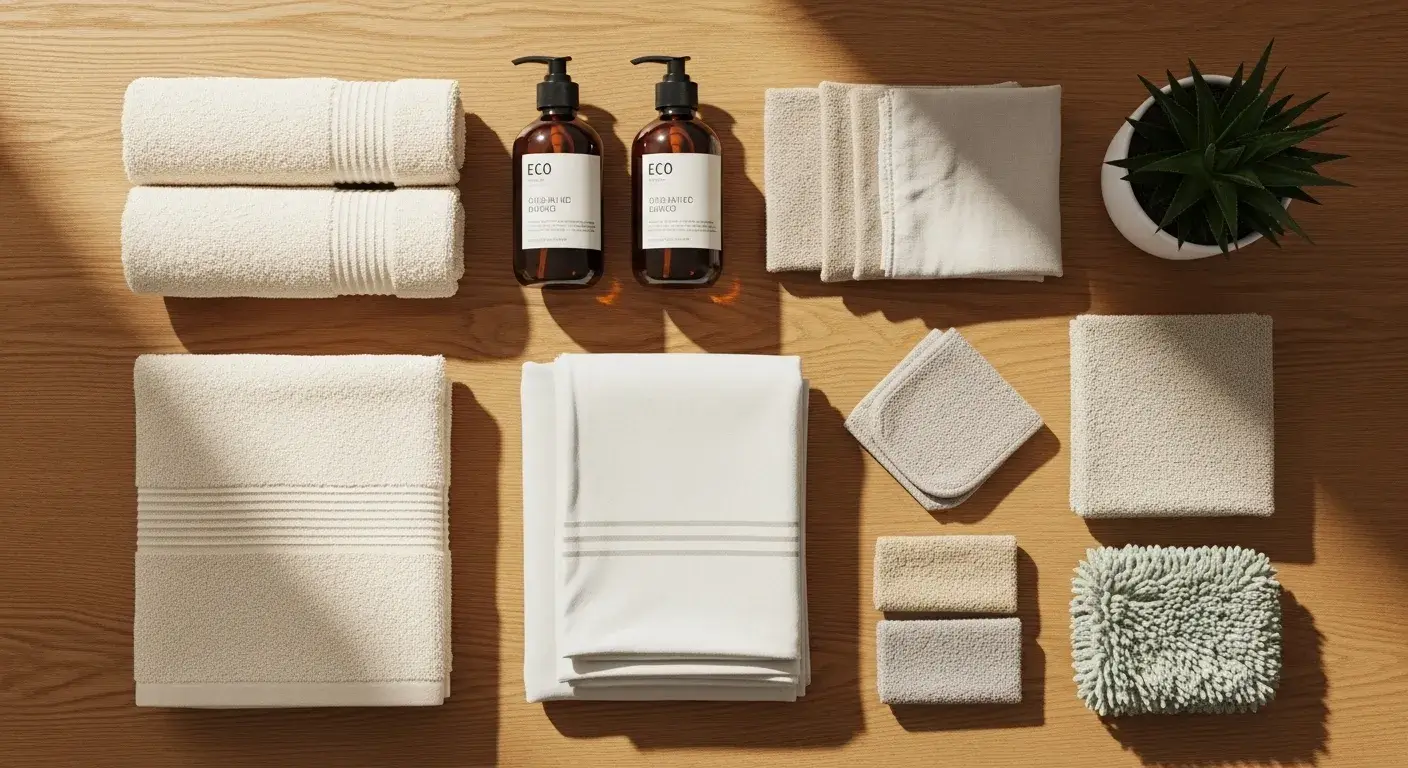
Cost-Saving Sustainable Alternatives
Eco-friendly doesn’t mean expensive. Many sustainable options provide better value through improved durability and lower resource consumption.
Textile Innovations:
- Bamboo fiber towels3 (30% more absorbent, faster drying)
- Recycled polyester bedding (40% longer lifespan)
- Organic cotton linens (reduced chemical processing costs)
- Hemp-blend fabrics (naturally antimicrobial)
Cleaning Supply Alternatives:
- Concentrated formulas (80% less packaging waste)
- Plant-based cleaners (safer for staff, guests)
- Refillable dispensers (60% cost reduction vs. single-use)
- Microfiber cloths (eliminate paper towel costs)
Guest Response and Market Trends
Environmental consciousness drives booking decisions for younger travelers. Millennials and Gen Z guests specifically seek sustainable accommodations.
| Age Group | Eco-Importance Rating | Willingness to Pay Premium |
|---|---|---|
| Gen Z (18-25) | 89% | 15-20% more |
| Millennials (26-40) | 82% | 10-15% more |
| Gen X (41-55) | 71% | 5-10% more |
| Boomers (56+) | 58% | 0-5% more |
Implementation Strategy
Start with high-impact, low-cost changes before investing in major sustainability initiatives. This approach builds momentum while demonstrating ROI.
Quick Wins (0-3 months):
- Switch to bulk soap dispensers
- Replace single-use items with refillables
- Upgrade to LED lighting throughout property
- Implement towel and linen reuse programs4
Medium-term Goals (3-12 months):
- Source eco-certified cleaning products
- Upgrade to sustainable bedding and towels
- Install energy-efficient appliances
- Create recycling programs for guests
Long-term Investments (1-3 years):
- Solar panel installation
- Water conservation systems
- LEED certification pursuit
- Local supplier partnerships
Sustainable supply chains also improve reliability. Local suppliers reduce shipping delays and transportation costs while supporting community relationships.
What’s the Most Cost-Effective Way to Source These Essential Items?
Smart procurement strategies reduce supply costs by 25-40% while ensuring consistent quality and reliable delivery. Timing, volume, and vendor relationships matter most.
Bulk purchasing, seasonal timing, and direct manufacturer relationships provide the best value for essential hotel supplies. Properties can reduce costs by 30% through strategic sourcing while improving quality consistency and delivery reliability.
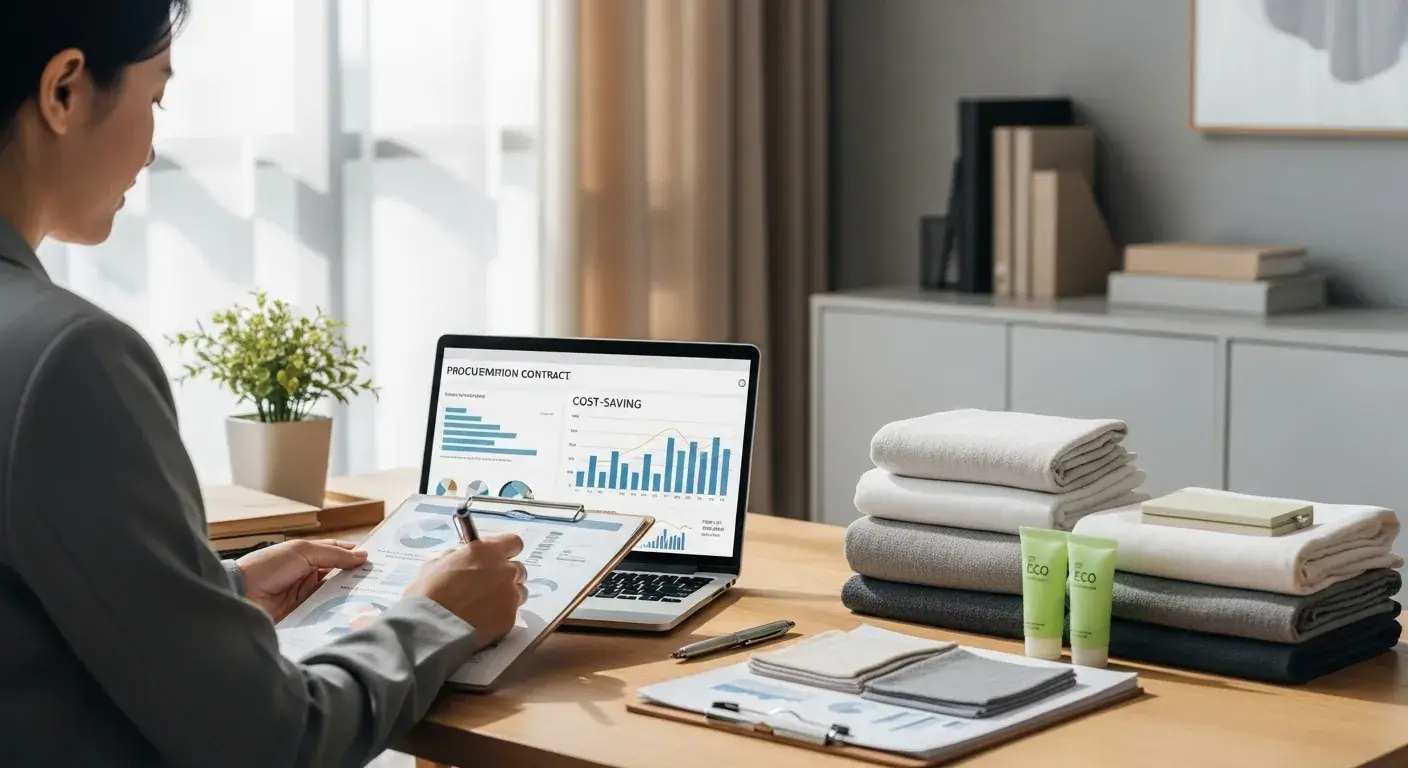
Vendor Selection Criteria
Choose suppliers based on these priority factors rather than price alone. Long-term partnerships provide more value than lowest-bid contracts.
Primary Evaluation Factors:
- Quality consistency across order batches
- On-time delivery performance (95%+ target)
- Minimum order quantities that match your needs
- Customer service responsiveness
- Return and exchange policies
Secondary Considerations:
- Geographic proximity for faster shipping
- Sustainability certifications and practices
- Custom branding and specification capabilities
- Payment terms and credit options
- Industry experience and references
Bulk Purchasing Strategies
Volume discounts provide significant savings, but require careful planning to avoid overstocking or cash flow problems.
Optimal Order Quantities by Property Size:
| Hotel Size | Order Frequency | Typical Savings | Storage Requirements |
|---|---|---|---|
| 20-50 rooms | Quarterly | 15-20% | Small warehouse space |
| 51-100 rooms | Monthly | 20-25% | Dedicated storage room |
| 101-200 rooms | Bi-weekly | 25-30% | Full warehouse facility |
| 200+ rooms | Weekly | 30-35% | Multiple storage areas |
Seasonal Procurement Planning
Timing purchases around industry cycles and seasonal demand reduces costs and ensures availability during peak periods.
Best Purchasing Windows:
- January-February: Linens and bedding (post-holiday clearances)
- March-April: Cleaning supplies (spring contracts)
- May-June: Technology items (pre-summer demand)
- September-October: Safety equipment (annual inspections)
- November-December: Amenities and gifts (holiday sourcing)
Items to Stock Before Peak Season:
- Extra bedding sets (20% above normal inventory)
- Additional towel inventory (30% increase)
- Cleaning supplies (6-month supply)
- Replacement parts for equipment
- Emergency backup items
Contract negotiations work best during off-peak periods when suppliers need business. Avoid procurement during industry trade shows when everyone competes for supplier attention.
Direct manufacturer relationships eliminate distributor markups but require larger minimum orders. This works best for standardized items like bedding, towels, and basic amenities.
Conclusion
Essential hotel supplies focus on guest comfort, operational efficiency, and safety compliance rather than luxury features. Smart procurement strategies reduce costs while maintaining quality standards.
-
J.D. Power’s 2025 North America Hotel Guest Satisfaction Index Study provides comprehensive data on guest preferences and satisfaction drivers across different hotel categories. ↩
-
Acme Textiles’ hospitality guide explains why thread counts between 250-400 provide the optimal balance of comfort, durability, and cost-effectiveness for hotels. ↩
-
Recent industry analysis shows sustainable textiles like bamboo fibers are growing fastest in hospitality due to their eco-friendly properties and operational advantages. ↩
-
The American Hotel and Lodging Association reports that towel reuse programs reduce laundry costs by 17% while extending textile lifespan. ↩
